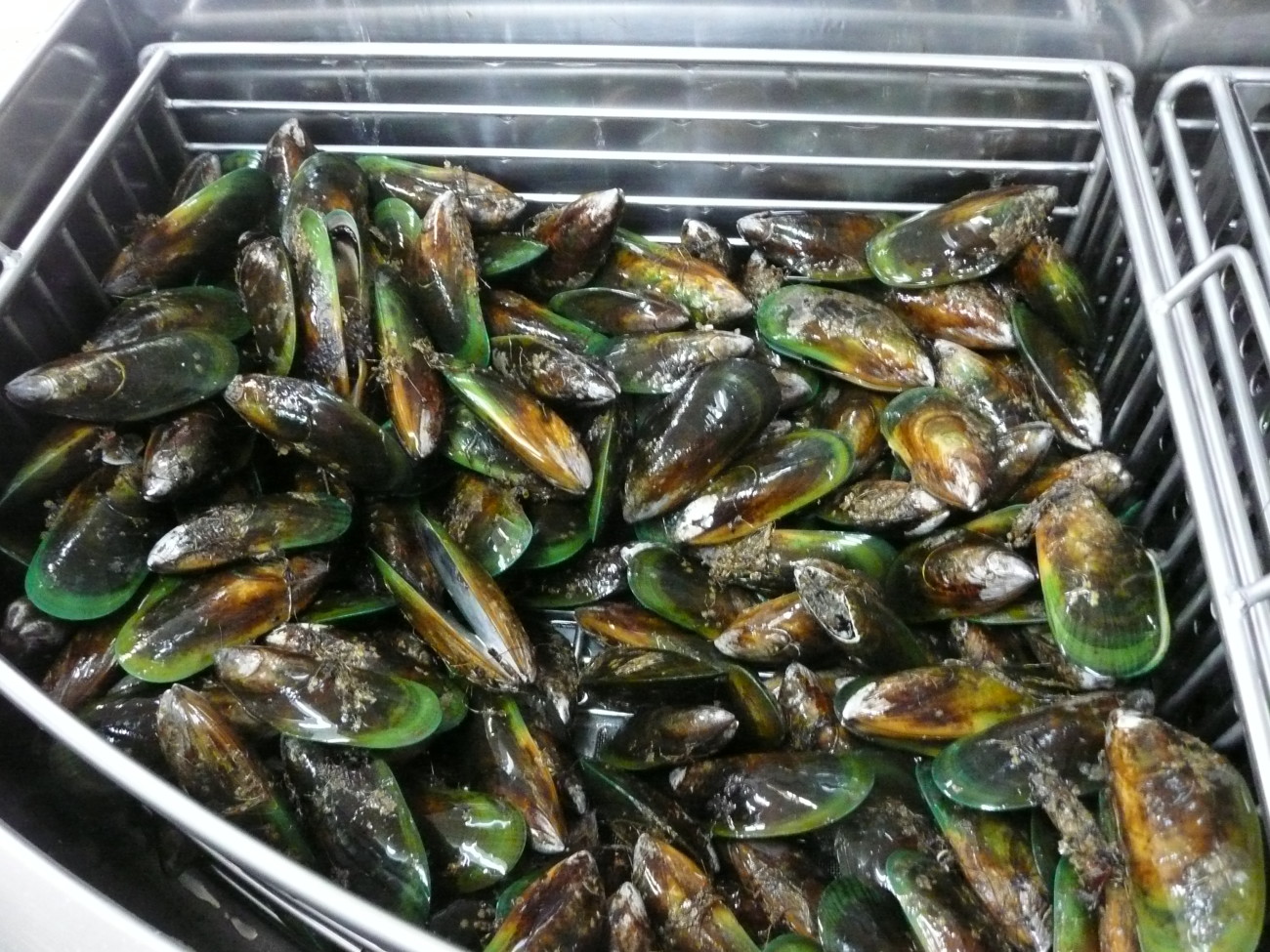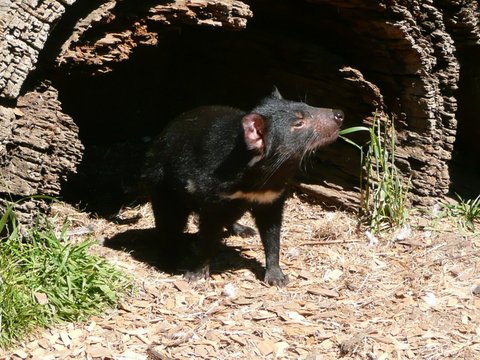
by Loti | Apr 18, 2013 | Animals, Food, New Zealand
New Zealand. Green Lipped Mussels. Very pretty and it turns out really good for you, too. Unfortunately they are endemic to New Zealand, meaning they only grow in the coastal waters of New Zealand. No where else. They are, however, exported to many countries including the U.S. If you have a dog and feed him/her Greenies, then you may be enhancing your dog’s diet with powdered green lipped muscles. The Joint Care Greenies are made from the mussels and have been shown in studies to help alleviate signs of arthritis in dogs. Cool! And if they help our dogs, wouldn’t the same go for us humans? Well, yes. In limited studies, freeze dried green lipped mussels have helped people with improved joint mobility and pain (you can buy them in capsules and no, this is not a recommendation for them). They are very high in Omega 3 and may rival fish oil some day. But the great thing about these mussels-they are one of the most environmentally friendly of any food we can eat. They are grown from wild spat (mussel seed harvested from seaweed washed up on the beach) on long ropes suspended in the ocean. They eat plankton so no feed is needed and they have zero impact on our environment. So next time you are in a restaurant, look for these beautiful, healthy for you mussels. I know I will!...

by Loti | Apr 11, 2013 | Animals, Endangered Species, Tasmania
Tasmania. So who is this cute little guy? Well the Tasmanian Devil, of course. What? There really is a Tasmanian Devil and he/she lives in Tasmania? And it is not a Looney Toon cartoon (remember Taz?). Well first, let’s figure out where Tasmania is since I didn’t know until I visited there a couple of years ago. Tasmania is an island located 150 miles off the Australian coast to the South. It is the only place in the world where the Tasmanian Devil lives in the wild. Outside of Australia, the only place to see the devils is the Copenhagen Zoo where 4 were presented as a gift when the Crown Prince of Denmark, whose Mother is Tasmanian, was born in 2005. No other zoos outside Australia have them. Weird. Devils are the largest carnivorous marsupial (quite a mouthful). Think back to biology, marsupials are mammals that carry their young in a pouch including kangaroos, possums and wombats (which happen to be the devil’s favorite food). Being carnivorous, they consume all of their prey including bones, skin and flesh acting as a vacuum cleaner for the forests. And they are yet another endangered species with 85% of the population being wiped out by a contagious facial cancer that spreads when the devils bite each other through mating or feeding. Scientists are trying to develop a cure and also establish disease free colonies to prevent possible extinction in the next 20 years. Let’s hope it works so you can see a devil next time you are in Tasmania! ...

by Loti | Apr 9, 2013 | Thailand
Thailand. Walking the beach in Thailand, I found one piece of sea glass and some really cool shells. That was enough to celebrate! For those of us hooked on collecting sea glass, each found piece is a new discovery. So a piece from Thailand. I was jumping with joy! Collecting sea glass (any weathered glass found on the beach or inland waterway) is popular around the world. In the US, there is a an online magazine, Sea Glass Journal, an association, North American Sea Glass Association, and even an annual festival in Virginia. Who would have thought? So what is the rarest color? Well it is orange (a color I have never seen) found in 1 out of 10,000 pieces. Brown, kelly green and white are the most common. And the color comes from the original use of the glass; a bottle, jar, plate, or window… And some, as you can see from the photo of pieces I have found in Palm Beach, have writing. Vacation places are even advertised as having good sea glass collecting. Maybe something to check out as you are making your vacation plans. And why collect it? Because, on just a very basic level, it makes us happy. And it is free, good exercise and fun. So see you on the beach and happy collecting. ...

by Loti | Apr 5, 2013 | Insects, Thailand
Thailand. My tent at The Four Seasons Elephant Camp was named The Butterfly and Beetle tent (each of the 15 tents had a different theme) so I was surrounded by butterflies, beetles and elephants. Quite the combo. And I was amazed at the number of different butterflies and moths in the framed mount shown in the photo. So what role do butterflies play in our world? It turns out big, besides being beautiful to watch. After bees, they are the world’s second largest pollinator. Something I have never really thought about much. But without pollination, the human race doesn’t survive. Wow. Of the 1400 crop plants grown in the world, 80% require pollination to reproduce. Pollination, simply put, is the transfer of pollen in and between flowers and is necessary for the plant to produce fruit and seeds. So most of the day to day things you consume need pollination. Think coffee, apples, spices, chocolate, potatoes, almonds and even tequila. And sadly, as with so many things, butterfly populations are declining worldwide as a result of loss of habitat, increased use of pesticides (especially with genetically engineered corn) and climate change. So next time you see a butterfly, appreciate it for all it contributes to your well being. Maybe plant some flowers that attract and feed them. Learn how you can help them. And just enjoy their beauty. I know I will! ...

by Loti | Apr 3, 2013 | Conquering Fear, Thailand
Thailand. Northern Thailand is mountainous and mysterious, at least from my point of view. Drug running, elephants and suspension bridges make my list of terrifying things (although elephants have definitely moved to the magical side). Suspension bridges have always held a morbid fascination for me. Along the same lines as airplanes. How do they stay in the air and since I am deathly afraid of heights…Well, they don’t always, as evidenced by the spectacular collapse of the Tacoma Narrows Bridge into the Puget Sound 4 months after it opened in 1940. No people were killed but a poor dog named Tubby bit the rescuer trying to save him and died. The longest suspension bridge in the world is located in Japan at almost 13,000 feet which is over 2.5 miles. China has 4 of the top 10 longest and the US has one in the top 10. The double-decker (gee, one deck is bad enough but 2?), Verrazano Narrows connects Staten Island to Brooklyn. The famous Golden Gate comes in at #11. So back to this suspension bridge. Feeling emboldened by my elephant ride, I decided to walk over this bridge by myself. Having never stepped foot on one before, I was hardly breathing. The faster I walked, the more it swayed so I had to slow down, breathe and I did it – both ways! With no one watching. Amazing. ...






